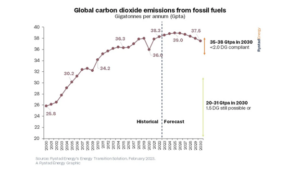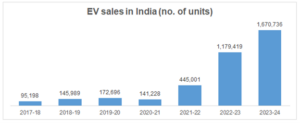India’s Carbon Journey Toward Net-Zero
Carbon emissions – the process of releasing carbon dioxide into the atmosphere, mostly from burning fossil fuels like coal, oil, and natural gas – hit a record high in 2022 as countries scrambled for innovative means of securing sustainable, reliable and affordable fuel for power generation following the Russian invasion of Ukraine (World Economic Forum, 2022). Discussions on carbon-intensive fuels as short-term solutions to address energy security crises led to the revival of coal plants and therefore the priority for cleaner energy alternatives took a backseat.

Carbon emissions remain a principal driver of climate change, contributing to rising sea levels, extreme weather events, ecosystem disruption, ocean acidification, air pollution, environmental degradation, and global warming. The Carbon Credit mechanism, introduced under the Kyoto Protocol in 1997 (United Nations Climate Change) and later reinforced by the Paris Agreement in 2015, sought to address these challenges by emphasizing the importance of carbon trading and emissions reduction targets.
The mechanism suggests a layered approach towards achieving net-zero emissions implying a balance where the amount of greenhouse gases released into the atmosphere equals the amount removed, effectively neutralizing the overall impact on the climate.
It allocates tradable “cap” permits representing the reduction or removal of one metric ton of carbon dioxide (or an equivalent greenhouse gas) from the atmosphere. Under the mechanism, the companies or countries may “trade” their unused credits with others that have exceeded their limits, thereby creating a financial incentive to reduce emissions as cutting pollution becomes profitable.
In essence, carbon credits are an attempt to carve a solution for carbon emission. Under the “cap and trade” system, an entity functioning within the emission limit saves money or earns revenue by selling credits. Meanwhile, those who can’t (or won’t) cut emissions can buy credits to offset their impact.
The UN’s Role in Reducing Global Carbon Emissions
The United Nations (UN) plays a significant role in addressing carbon emissions both globally and within its own operations. As the central body coordinating international efforts to combat climate change, the UN’s most prominent contributions include the Paris Agreement (2015) (United Nations Climate Change), a landmark accord aimed at limiting global temperature rise, and the Emissions Gap Report series (United Nations Environment Programme), which tracks global progress toward keeping warming well below 2°C while pursuing 1.5°C in line with the Paris goals.
Despite these achievements, the UN’s climate initiatives continue to face several obstacles. Under the Paris Agreement, countries submit voluntary Nationally Determined Contributions (NDCs) outlining their plans to cut greenhouse gas emissions. However, many nations, including major emitters like China and the United States, are not on track to meet these targets, raising concerns about the agreement’s effectiveness while setting a trend of inconsistent commitments towards a cause aimed at global common good. Compounding this, the UN lacks the legal authority to enforce emission reductions, relying instead on diplomacy, transparency mechanisms, and public pressure, tools that, while important, often fall short of ensuring compliance.
Over the years, the UN has taken steps to reduce its internal carbon emissions through efforts such as the Greening the Blue Initiative (United Nations Environment Programme, 2024), which seeks to make UN operations more sustainable, and the Sustainability Strategy 2020-2030 Plan (UN Chief Executives Board for Coordination, 2019) which aims to minimize environmental impacts via energy efficiency, renewable energy adoption, and carbon offsetting. However, critics argue that offsetting does not always result in real emission reductions, casting doubt on its long-term effectiveness.
India’s Role in Global Carbon Governance
India has established a comprehensive framework to address carbon emissions, driven by its commitments under the Paris Agreement and its own sustainable development goals. It has been a significant participant in the global carbon credit market, particularly through the Clean Development Mechanism (CDM) under the Kyoto Protocol (United Nations Climate Change). The CDM allows for developing countries like India to earn carbon credits by implementing projects that reduce greenhouse gas emissions, such as wind farms, solar power plants, or energy-efficient technologies.
India aims to achieve net-zero carbon emissions by 2070, a long-term goal that aligns with global efforts to limit temperature rise. India’s updated Nationally Determined Contributions (NDCs) (Government of India, 2022) set specific goals for 2030, including reducing the emissions intensity of its GDP by 45% from 2005 levels (Press Information Bureau, 2022), meeting 50% of energy needs from renewable sources, and cutting total projected carbon emissions by one billion tonnes. The NDCs also emphasize creating an additional carbon sink of 2.5 to 3 billion tonnes of CO2 equivalent through expanded forest and tree cover (Press Information Bureau, 2024). As of the latest India State of Forest Report, India’s forest and tree cover accounts for 25.17% (Press Information Bureau, 2024).
Additionally, India has set a target of developing 500 GW of non-fossil energy capacity by 2030, focusing on solar, wind, and hydroelectric power. To achieve these goals, the government has implemented an extensive legal and institutional framework under the National Action Plan on Climate Change (NAPCC), which prioritises solar energy, energy efficiency, sustainable habitats, water management, Himalayan ecosystem preservation, afforestation, sustainable agriculture, and climate knowledge dissemination (Press Information Bureau, 2021).
The Energy Conservation (Amendment) Act, 2022 empowers the government to establish a national carbon credit trading scheme and mandates the use of non-fossil energy sources while enhancing energy efficiency across industries and transport sectors. Meanwhile, the National Green Hydrogen Mission (Department of New and Renewable Energy) targets the production of five million metric tonnes of green hydrogen annually by 2030 to decarbonize heavy industries such as refineries and fertilizer production. Simultaneously, India is also developing a carbon market compliance mechanism based on emissions intensity targets, initially covering sectors like petrochemicals, iron and steel, cement, and pulp and paper, with trading expected to begin in 2025.
Electric mobility represents another key pillar of India’s decarbonization strategy. The government envisions a rapid transition to electric vehicles (EVs), particularly two- and three-wheelers with a mandate that all new two-wheelers be electric by 2026 (India Brand Equity Foundation, 2025).

EV sales in India have seen a remarkable upward trajectory in recent years, largely driven by growth in the two- and three-wheeler segments. As shown in the above chart, V sales increased from 95,198 units in 2017–18 to 1,670,736 units in 2023–24, reflecting a compound annual growth rate (CAGR) of 61%.
India’s Challenges
While India has made steady progress in reducing its emissions intensity, its total emissions are projected to continue rising due to sustained economic growth and developmental imperatives. Despite its ambitious policy framework, India faces several challenges in its carbon emission policies.
Foremost among these is its continued dependence on coal, which remains the backbone of natural energy production. Coal contributes for 55% of the total national energy mix (Press Information Bureau, 2025), posing a significant obstacle to achieving deep decarbonisation in the near term.
Policy enforcement also remains uneven, especially at the state and local levels. The initial phase of India’s Carbon Credit Trading Scheme (CCTS) focuses on major industrial sectors responsible for a large share of emissions but excludes high-impact sectors such as electricity generation and agriculture. Given their substantial contribution to greenhouse gas emissions, these omissions limit the overall scope and effectiveness of the scheme. Consequently, the market’s early depth and price discovery potential may be constrained, reducing its capacity to generate a strong national carbon price signal.
India’s Progress
Despite these headwinds, India has made substantial progress in reducing emissions intensity and expanding its renewable capacity. Between 2005 and 2023, India reduced its emissions intensity by 39% (Press Information Bureau, 2023) and is projected to meet or surpass its 2030 target. India is the world’s third-largest producer of solar energy and continues to expand its renewable energy portfolio at pace, with non-fossil capacity expected to surpass current targets. Efforts to increase forest and tree cover have further contributedto carbon sequestration, keeping the country on track to meet its carbon sink target for 2030.
Emphasis on Equity in Climate Action
India’s carbon emission policies are shaped by its emphasis on equity and the principle of common but differentiated responsibilities (CBDR). India highlights that developed countries bear greater historical responsibility for emissions and should take the lead in mitigation efforts.
India has voiced the necessity of financial support and technology transfer from developed nations to help achieve its climate goals. It co-founded the International Solar Alliance (ISA) and has been a vocal advocate for climate justice, emphasizing the need for developed countries to provide resources to support developing nations.
The Way Forward
India’s journey with carbon credit displays its enduring commitment to combatting climate change while balancing developmental priorities. Given that India’s coal dependency remains high, nuclear energy, including thorium-based reactors, may play an increasingly integral role in India’s decarbonisation strategy. With one of the world’s largest thorium reserves, India is uniquely positioned to develop thorium-fuelled reactors, offering a potential breakthrough in secure and low-carbon power generation.
The success of India’s domestic carbon market depends on the interplay of project management, stakeholder collaboration, and political will to have effective implementation. If pursued sincerely, the carbon credit mechanism could play a pivotal role in helping India achieve its ambitious sustainability goals.
Bibliography
- World Economic Forum, ‘Analysis: Global CO2 emissions from fossil fuels hits record high in 2022’,November 2022,URL: Global CO2 emissions from fossil fuels at new record in 2022 | World Economic Forum
- United Nations Climate Change, ‘ Mechanisms Under the Kyoto Protocol’, URL: Mechanisms under the Kyoto Protocol | UNFCCC
- United Nations Climate Change, ‘The Paris Agreement’, URL: The Paris Agreement | UNFCCC
- United Nations Environment Programme, ‘Emissions Gap Report’, URL: Emissions Gap Report
- United Nations Environment Programme,’ Greening the Blue’, 2024, URL: Annual-Report-2024-GtB.pdf
- UN Chief Executives Board for Coordination, ‘ Strategy for sustainability management in the United Nations System, May 2019, URL: CEB.2019.1.Add_.1 – Sustainability Management 2020-2030_Phase I_0.pdf
- United Nations Climate Change, ‘The Clean Development Mechanism’, URL: The Clean Development Mechanism | UNFCCC
- Government of India, ‘India’s Updated First Nationally Determined Contribution Under Paris Agreement’, August 2022, URL: Microsoft Word – V5 NDC submission to UNFCCC
- Press Information Bureau, ‘India stands committed to reduce Emissions Intensity of its GDP by 45 percent by 2030, from 2005 level,’ December 2022, URL: Press Release:Press Information Bureau
- Press Information Bureau, ‘Creation of Additional Carbon Sink’, February 2024, URL: Press Release: Press Information Bureau
- Press Information Bureau, ‘Union Minister Bhupender Yadav Releases India State of Forest Report 2023’, December 2024, URL: Press Release:Press Information Bureau
- Press Information Bureau, ‘National Action Plan on Climate Change (NAPCC)’, December 2021, URL: doc202112101.pdf
- Power Ministry of India, Government of India , ‘The Energy Conservation Amendment Act’, 2022, , URL: The Energy Conservation (Amendment) Act, 2022 | Government of India | Ministry of Power
- National Green Hydrogen Mission, Department of New and Renewable Energy. URL: NATIONAL GREEN HYDROGEN MISSION | New & Renewable Energy Department | India
- India Brand Equity Foundation, ‘India Brand Equity Foundation + EV Sales in India statistics,’ January, 2025, URL: https://ibef.org/research/case-study/india-s-electric-vehicle-revolution-trends-challenges-and-opportunities
- Press Information Bureau, ‘ India’s Coal Boom’, February 2025, URL: doc2025210497701.pdf
- Press Information Bureau, ‘India is committed to achieve the Net Zero emissions target by 2070 as announced by PM Modi, says Dr. Jitendra Singh’, September 2023, URL: Press Release: Press Information Bureau



